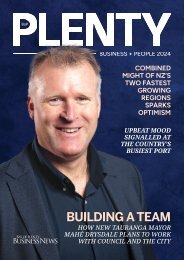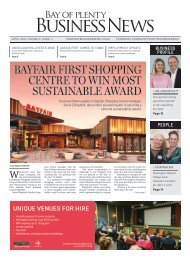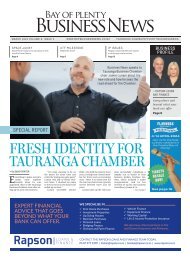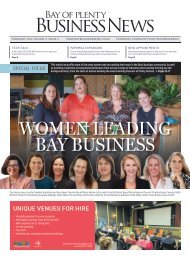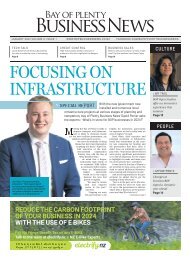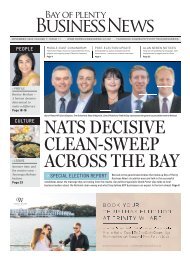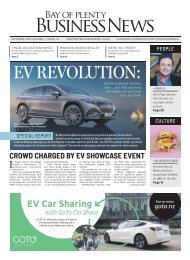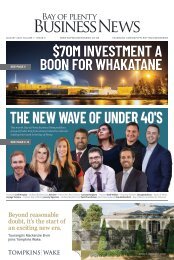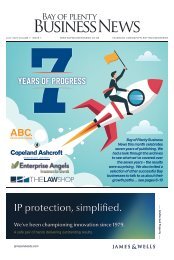May 2021 - Bay of Plenty Business News
From mid-2016 Bay of Plenty businesses have a new voice, Bay of Plenty Business News. This new publication reflects the region’s growth and importance as part of the wider central North Island economy.
From mid-2016 Bay of Plenty businesses have a new voice, Bay of Plenty Business News. This new publication reflects the region’s growth and importance as part of the wider central North Island economy.
Create successful ePaper yourself
Turn your PDF publications into a flip-book with our unique Google optimized e-Paper software.
<strong>May</strong> <strong>2021</strong> BAY OF PLENTY BUSINESS NEWS 19<br />
WFH doesn’t mean<br />
you’re TOOC<br />
In pre-Covid days, if you created copyright works such as drawings<br />
or source code as part <strong>of</strong> your job, the odds are you would have<br />
done so during “normal <strong>of</strong>fice hours” at your desk rather than at 9<br />
o’clock at night in the comfort <strong>of</strong> your own home. It would have been<br />
straightforward to establish who was the owner <strong>of</strong> copyright (TOOC)<br />
in those drawings or source code.<br />
INTELLECTUAL PROPERTY ISSUES<br />
> BY BEN CAIN<br />
Ben Cain is a Senior Associate at James & Wells and a Resolution<br />
Institute-accredited mediator. He can be contacted at 07 928 4470<br />
(Tauranga), 07 957 5660 (Hamilton), and benc@jaws.co.nz.<br />
In these Covid-affected times,<br />
however, many <strong>of</strong>fice-based<br />
employees now work flexible<br />
hours and work from home<br />
(WFH).<br />
Indeed, the 8.30am – 5pm<br />
day in the <strong>of</strong>fice has almost<br />
become a rarity rather than the<br />
norm. As a result, ascertaining<br />
who is the owner <strong>of</strong> copyright<br />
in drawings or source code<br />
may be a little harder to discern;<br />
or at least, the topic may<br />
be open for greater debate.<br />
The need to be sure <strong>of</strong><br />
who owns what in an employment<br />
context is perhaps more<br />
important now than it used to<br />
be.<br />
The recent case <strong>of</strong> Michael<br />
Penhallurick v MD5 Ltd [<strong>2021</strong>]<br />
EWHC 293 in the Intellectual<br />
Property Enterprise Court in<br />
England, although relating to<br />
events pre-Covid, illustrates<br />
this need.<br />
Penhallurick, a former<br />
employee <strong>of</strong> MD5, claimed<br />
ownership <strong>of</strong> copyright in eight<br />
works relating to a technique<br />
he named “Virtual Forensic<br />
Computing” or “VFC”.*<br />
The eight works comprised<br />
different versions <strong>of</strong> the s<strong>of</strong>tware<br />
code (literary works), a<br />
graphic user interface (artistic<br />
work) and a user guide (literary<br />
work).<br />
It was established that the<br />
first two works – the earliest<br />
version <strong>of</strong> the VFC source code<br />
and the object code compiled<br />
from this code – were created<br />
in 2005 and 2006, before Penhallurick<br />
was employed by<br />
MD5 in November 2006.<br />
The Court found these<br />
works were not relevant to<br />
Penhallurick’s claim and consequently<br />
focused its assessment<br />
on the remaining six<br />
works created by him after he<br />
joined MD5.<br />
Identifying the author<br />
The Court found Penhallurick<br />
was the author <strong>of</strong> the six<br />
remaining works and therefore<br />
was the first owner <strong>of</strong> copyright<br />
in them – unless any<br />
were made in the course <strong>of</strong><br />
his employment by MD5 pursuant<br />
to the IP clause in Penhallurick’s<br />
employment agreements,<br />
in which case MD5 was<br />
the first owner.<br />
Which <strong>of</strong> these was the case<br />
turned on the meaning <strong>of</strong> “in<br />
the course <strong>of</strong> his employment”.<br />
Why? Because <strong>of</strong> the poor<br />
wording <strong>of</strong> the “Job Titles and<br />
Duties” and intellectual property<br />
clauses in Penhallurick’s<br />
first employment agreement.<br />
The Court ultimately found<br />
that all <strong>of</strong> the works had been<br />
created by Penhallurick in the<br />
course <strong>of</strong> his employment with<br />
MD5.<br />
Of particular interest to<br />
this author, and relevance to<br />
this article given the current<br />
fashion for working flexible<br />
hours from home, however, is<br />
the Court’s finding in relation<br />
to the third and fourth copyright<br />
works (“VFC Version 1”<br />
and the graphical user interface<br />
(“GUI”) for VFC Version<br />
1) created by Penhallurick<br />
in 2007. In respect <strong>of</strong> these<br />
works, the Court said:<br />
“[66] … It seems that Mr<br />
Penhallurick took on the task<br />
[<strong>of</strong> developing VFC Version<br />
1 and GUI] with enthusiasm,<br />
to the extent that he took his<br />
In these Covid-affected times, however,<br />
many <strong>of</strong>fice-based employees now work<br />
flexible hours and work from home<br />
(WFH).”<br />
work home some <strong>of</strong> the time.<br />
His staff annual appraisal <strong>of</strong><br />
August 2007 suggests that<br />
much <strong>of</strong> the work must have<br />
been done during working<br />
hours at MD5.<br />
“But whatever the exact<br />
proportion done at home, it<br />
does not displace the strong<br />
and primary indication that it<br />
was work done in the course<br />
<strong>of</strong> his employment. The fact<br />
that an employee does work at<br />
home is relevant to the question<br />
<strong>of</strong> whether the work is <strong>of</strong> a<br />
nature to fall within the scope<br />
<strong>of</strong> the duties for which he is<br />
paid but it may or may not<br />
carry much weight.<br />
“Where it is otherwise<br />
clear that the work is <strong>of</strong> such<br />
a nature, in my view the place<br />
where the employee chooses to<br />
do the work will not generally<br />
make any difference. The same<br />
applies to the ownership <strong>of</strong> the<br />
tools the employee chooses<br />
to use, here sometimes Mr<br />
Penhallurick’s own computer<br />
system.<br />
“If it is clear that the<br />
employee is being paid to<br />
carry out a task as agreed with<br />
his employer, he may choose<br />
to use tools supplied by his<br />
employer or his own tools;<br />
either way, the task is carried<br />
out in the course <strong>of</strong> his<br />
employment.”<br />
Although it is not stated, I<br />
am confident the same reasoning<br />
applies to the time <strong>of</strong> day<br />
the employee chooses to do the<br />
work – that is, it doesn’t matter<br />
whether you do the work<br />
at 10am or 10pm, if the work<br />
is carried out in the course <strong>of</strong><br />
your employment then any<br />
copyright rights in it will be<br />
owned by your employer.<br />
What employees and<br />
employers should do<br />
Standing back, Penhallurick’s<br />
case identifies two important<br />
‘‘take homes” for both<br />
employers and employees:<br />
• First, if an employer is<br />
going to make use <strong>of</strong> copyright<br />
works created by an<br />
employee before that person<br />
is an employee, then<br />
the employer should have<br />
the employee assign copyright<br />
in those works to the<br />
employer at the same time<br />
the employee becomes an<br />
employee. Alternatively,<br />
execute a licence agreement<br />
with the employee at<br />
the same time the employee<br />
becomes an employee<br />
to enable those works to<br />
be lawfully used by the<br />
employer;<br />
• Second, the employer<br />
should ensure employment<br />
agreements, but particularly<br />
those with employees<br />
whose job it is to create<br />
intellectual property,<br />
adequately identify an<br />
employee’s role and scope<br />
<strong>of</strong> duties so that it is clear<br />
what resulting intellectual<br />
property the employer is<br />
laying claim to by virtue <strong>of</strong><br />
the employment agreement,<br />
irrespective <strong>of</strong> what time <strong>of</strong><br />
day and where that intellectual<br />
property is created.<br />
* VFC is a method <strong>of</strong> retrieving<br />
an image <strong>of</strong> the hard disk without<br />
writing on it, then booting<br />
up the image on a virtual<br />
machine so that the image can<br />
be investigated. In developing<br />
the technique, Penhallurick<br />
had used a freely available<br />
product called VM S<strong>of</strong>tware<br />
to set up the replica <strong>of</strong> the<br />
target computer’s hardware<br />
and operating system. As computer<br />
programs generally have<br />
inbuilt safeguards to prevent<br />
them from being manipulated<br />
in this way, the method developed<br />
by Penhallurick involved<br />
a password bypass feature.<br />
BEWARE OF FOREIGN IMITATIONS.<br />
There’s no shortage <strong>of</strong> great ideas in New Zealand.<br />
But for an innovative bunch, we’re not the best at<br />
realising the full potential <strong>of</strong> our innovations, particularly<br />
when exporting them.<br />
At James & Wells, we can identify your competitive<br />
edge, <strong>of</strong>fer business strategies for specific markets and<br />
help you own and leverage your intellectual property to<br />
ensure no one steals the fruit <strong>of</strong> your labour.<br />
www.jaws.co.nz | +64 7 928 4470



